|
MICHAEL
COLLINS: A SCORE’S WORTH OF PI DAN
FORTUNE - by Ed Lynskey
Over the past five decades, crime author Dennis Lynds, writing under the pseudonym Michael Collins (named after an Irish patriot) has produced nineteen books featuring PI Dan Fortune. In 1988, the Private Eye Writers of America presented him with the Lifetime Achievement Award in recognition of his contributions to this mystery fiction subgenre, and in 2002 the SoCal Chapter of MWA awarded him its Marlowe Lifetime Achievement Award. The one-armed Polish-Lithuanian private investigator operating in the Chelsea section in New York City, Dan Fortune (born Fortunowski) has proven a durable, vibrant protagonist, even through the ups and downs in popularity of private eyes. Dennis Lynds has authored several series under a host of pseudonyms (William Arden, Carl Dekker, Mark Sadler, John Crowe, Maxwell Grant, and Michael Collins) but the Dan Fortune series has remains his best known. Mr. Lynds didn’t start out writing crime fiction. His debut novel, Combat Soldier, however, published in 1962 as Dennis Lynds, introduced the gritty tone, fast pace, and muscular prose that characterized the later PI novels. The front cover blurb reads, “In the blood and slaughter of battle, death was his only enemy.” The main character, Jonathan Jackson (“free, white, and twenty-four”), no doubt is drawn from the author’s own war experience (a decorated infantryman from 1943-46). As a warm-up act to the Dan Fortune oeuvre, Collins penned eight novels starring The Shadow (1964-67) under the house name Maxwell Grant. Once this revival attempt petered out, Collins brought out Act of Fear in 1967, and in the following year it garnered an Edgar for the Best First Mystery Novel from the Mystery Writers of America. Ross Macdonald, who also wrote a laudatory blurb for the jacket cover, was perhaps instrumental in the book’s success. Macdonald commented, “Act of Fear is the most interesting private detective novel I have read in a long time. It is a highly original piece of work in a field not noted for much originality. Mr. Collins is a writer to watch and above all to read.” In Act of Fear, Dan “Pirate” Fortune looks for the missing Jo-Jo Olsen but what looks to be a missing person case deteriorates into murder. Captain Gazzo and Dan’s girlfriend Marty Adair are installed as series regulars. Dan’s diverse, volatile Chelsea setting is introduced as well. The debut PI Dan Fortune novel had an interesting pedigree. At age 41, Collins had moved from New York City to Santa Barbara, California, and befriended Ross Macdonald (“We took to each other quite a bit.”). A sort of West Coast Algonquin Round Table of crime authors met every other Wednesday for lunch at a neighborhood bar-and-grill called Harry’s El Cielito. Other members included William Campbell Gault and Davis Dresser (Brett Halliday). Collins attended these get-togethers headed by Macdonald. Always a champion of neophyte writers, Macdonald also wrote a letter of introduction on Collins’ behalf to his old editor Ray Bond at Dodd, Mead paving the way for Act of Fear’s publication. Macdonald also hooked Collins up with literary agent Dorothy Olding. Anthony Boucher writing the fabled “Criminals At Large” column for the New York Times Book Review (NYTBR) since 1951 died on April 29, 1968. The announcement of the Collins’ Edgar win then fell to Allen J. Hurbin. Book critics wholeheartedly agreed with the choice. Los Angles Times Book Review called Act of Fear “sharp as the proverbial tack.” Washington Post noted the book was “highly entertaining; plenty of action.” The Brass Rainbow, number two in 1969, muted its action, and was what Hubin in NYTBR called a “softer yarn” which also “strongly reminded” him of Ross Macdonald’s Lew Archer. The hard-boiled tone remained “skillfully plotted with finely honed suspense.” San Francisco Chronicle called it “an excellent series detective” while Baltimore News American raved “another exceptional story.” In The Brass Rainbow Dan is asked to alibi for a gambler who may’ve murdered a man. Things unravel from that point. One of the many quotable lines in this literate novel reads, “Life begins in darkness and ends in darkness and in between is a nightmare.” The avuncular Captain Gazzo, Dan’s cop friend, also makes his appearance. Bantam Books splashed an ad for Philip Roth’s bestselling Portnoy’s Complaint on the rear cover of the paperback edition (later joked about by Collins in Night of the Toads). Not surprisingly, Collins put on The Brass Rainbow’s dedication page, “To KEN MILLAR, with thanks.” 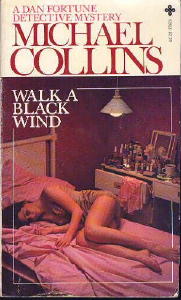 The third Dan Fortune
touted the colorful
title Night of the Toads
(1970). The now defunct Washington
Star wrote “Michael Collins handles an excellent and complex
plot with ease.” The PI hunts for the killer of an actress named
Anne Terry in New York City’s theater crowd. His real motive is
to take down a rich, arrogant actor named Ricardo Vega who had him
roughed up. Captain “The Preacher” Gazzo plays a significant role
in this saga as does Dan’s waifish girlfriend, Marty Adair. This
is a satisfying PI tale with a large ensemble of characters and a
honeycomb plot. The third Dan Fortune
touted the colorful
title Night of the Toads
(1970). The now defunct Washington
Star wrote “Michael Collins handles an excellent and complex
plot with ease.” The PI hunts for the killer of an actress named
Anne Terry in New York City’s theater crowd. His real motive is
to take down a rich, arrogant actor named Ricardo Vega who had him
roughed up. Captain “The Preacher” Gazzo plays a significant role
in this saga as does Dan’s waifish girlfriend, Marty Adair. This
is a satisfying PI tale with a large ensemble of characters and a
honeycomb plot. The fourth caper, Walk a Black Wind (1971), is dedicated to the author’s second daughter, Deirdre. PI Dan Fortune is hired by John F. Andera to nail the killer of a girl he’s only known for two weeks. Gazzo thinks a pro did the hit. Dan has to verify it. Early on in the novel, Gazzo wryly remarks, upon seeing a corpse, “I know all the violence, but I never get used to the young ones. Especially not the girls.” Commenting on this novel, National Observer drew a parallel that was gaining wider acceptance among Dan Fortune’s champions, “Dan Fortune is a kind of New York City counterpart to Ross Macdonald’s Lew Archer.” 1972’s novel five was titled Shadow of a Tiger. The dust jacket copy wrongly predicted the author would never leave New York City, “that complex city-world where everything changes and yet never changes.” NYTBR’s Newgate Callendar (a pseudonym used by Pulitzer Prize-winning music critic Harold Schonberg) found much to admire about it. Under the surface of a detective yarn he observed “a lament for the lonely people, for the hopelessness of aspiration, for the bitterness of life.” Callendar saw Collins as a logical extension of the Hammett-Chandler-Macdonald PI bloodlines. He also wrote, “He [Collins] is completely objective, does little editorializing, and lets his characters speak for themselves.” Indeed, Collins assembled a cast of disparate characters including a hero of the French Underground and New York City punks to whip up a twisty, intricate plot. Somehow by the novel’s end, the pieces are all made to fit together. In 1973, The Silent Scream, Dan’s sixth appearance in book form, snagged flush critical acclaim from the NYTBR. By now Collins was a “dependable” PI writer who wrote “a novel of action” as well as “a novel full of insights.” Collins was said to ably work within the private-eye conventions but “very few in the field have his surety.” Callendar found “no preaching, no heavy breathing” and praised the ending as “a kind of catharsis.” This mix of diverse characters, everything from a Mafia don to a New England blueblood politician, propelled a multi-faceted plot. One of the last chapters uses a closed room plot device where Dan goes to rather elaborate lengths to explain the solution to the murders. 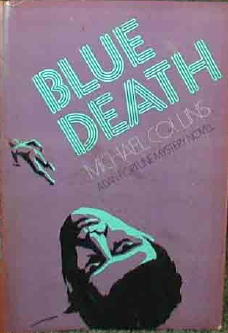 Blue Death in 1975 (number seven) finds Dan Fortune snooping in big business (International Metals and Refining Corporation) where a murdered scientist has refined a process to manufacture pure titanium. No doubt Collins used his chemistry degree and background in editing chemical engineering journals to create the strong realism of the tale. Dan makes a West Coast trip to visit a skunk works operation. Meanwhile, his NYC Chelsea office, with a window looking out on a ventilation shaft, is slated for the wrecking ball. Dan Fortune’s eventual transfer to the West Coast is thus set into motion. Carl Pike, the object of Dan’s search in Blue Death, gives the book its gaudy title: “When there’s nothing left to dream, you’re dead. A blue death, oxygen-starved. My life is over.” An interesting added wrinkle is Dan meeting a fellow PI, Aviva Galt from Philadelphia, PI Carney Wilde’s (Bart Spicer) old haunts. Aviva is “a big woman, mannish, but curved female.” Publishers Weekly aptly evaluated Blue Death as “a satisfying intricate mystery. Action and intrigue are nicely mixed.” For the nation’s bicentennial in 1976, Collins produced The Blood-Red Dream. Critics hailed number eight as a vigorous entry. NYTBR raved, “Collins tells the story with compassion for the human condition and introduces some sharply drawn characters en route.” Detroit News commented that Dan Fortune was “in splendid form” while Booklist saw “a fast-paced thriller with some interesting twists.” Somewhat dated by events in today’s world order, the novel concerns a group of “freedom fighters” out to break the Iron Curtain’s grip on Eastern Europe. Social commentary and political positions compete with the main narrative about a client’s missing grandfather whom Dan Fortune is retained to locate. For the most part, plot and characterization hold up quite well. The Nightrunners (number nine) appeared in 1978. It’s a corker of a book. A pharmaceuticals magnate retains Dan Fortune to fetch his brother, a compulsive gambler, home. Fortune unearths instead how the brother is involved in a scheme to free the magnate’s idealistic son from a Mexican jail. The boy has been imprisoned selling tainted antibiotics. Buffalo Evening News gave this novel solid marks for “briskly paced, tersely told.” NYTBR gave praise by saying, “Mr. Collins juggles everything around like the expert he is, and the complications are nicely resolved.” The Slasher in 1980 kicked off Dan Fortune’s third decade. Washington Post Book World cheered the book as told “with skill and finesse” while Publishers Weekly summed it up as “smashing.” However, NYTBR had begun to tire of the series. Callendar explained, “Some of the Fortune books are tight, realistic, well-plotted. Others are routine, or wallowing in self-pity and the usual alienation symbols that have been around since Hammett and Black Mask. The Slasher turns out to be one of the lesser books in the series.” He went on to complain about “too much moralizing.” Having read and absorbed the most of the PI Dan Fortune canon, I found The Slasher to be a believable, rousing, if not intriguing read. It also marks a transition novel. His ex-lover Marty Adair of five years hence calls Dan Fortune to the West Coast. Eventually, Fortune will fall in love with the Gold Coast enough to relocate there. Marty’s niece is found dead and mutilated in a canyon. A nebulous “Canyon Slasher” is blamed as the culprit. In his investigation, Dan traffics through seedy, poor barrios as well as tawdry, affluent Malibu-Santa Barbara. His future model girlfriend Kay Michaels makes her debut. Entertaining episodes include a TV quiz game show called RISK! and a rich but deserved skewering of those celebrated authors of bloated bestsellers. The eleventh Dan Fortune came in 1983 with the arrival of Freak. The trade journals praised it. EQMM said, “Like Ross Macdonald, Michael Collins can write vivid prose and dialogue and plot a mystery.” Kirkus Reviews weighed in with the comments “solid work in the hard-boiled vein: taut, fast, and literate.” Publishers Weekly thought “the characters are varied and nicely drawn.” Freak does not make for good bedtime reading. Its raw, brisk plot juices and does not relax the nerves. A wealthy computer executive brings in Dan to track down his son, who may or may not want to return home. The novel is lean on socio-political commentary, while heavy on several inventive but jarring plot twists. The wry humor is intact. Dan, as always, frets about losing his remaining arm. He jokes, “Sometimes I wonder if the arm thinks about me.” The villains are multi-dimensional and, yes, a bit bizarre. By the novel’s end, the self-effacing Dan Fortune has identified three “freaks,” himself included. 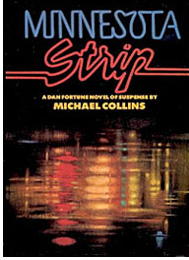 Four years later, in 1987, Collins brought out the twelfth Dan Fortune saga, Minnesota Strip, the first published with Donald I Fine. By late 1988, Dodd Mead, his publisher since the first novel, after being in business since 1839, was headed for liquidation. By now, critics (if not readers) had bought into the idea of the social-political themes underpinning the Dan Fortune detective novels. Library Journal stated “the Dan Fortune novels are a strong indictment of the injustices that plague our society.” San Diego Union echoed how “it displays a depth, especially in its examination of moral questions, which puts it a cut above many of its peers.” The embittered brother of a Viet Nam vet killed in the last days of the war becomes a domestic terrorist. This novel is about the aftermath of war. A Vietnamese girl chases fame to attain the American Dream and ends up gunned down in an alley, her clothes and jewelry stripped off by thieves (an allusion to Christ?). Dan Fortune as a hardboiled philosopher-maverick remains the real deal. He drinks his Beck beer, packs his “old cannon,” never lies to the cops, and talks to men attired in regimental neckties. Kay Michaels, his love interest in Santa Barbara, is enticing him to come live in California permanently. For now, Dan travels between a shabby brothel in Chelsea to the opulent mansion of a California businessman. Number thirteen in the series, Red Rosa in 1988, was anything but unlucky. It rocked. Dan is asked to investigate the shooting of Rosa Gruenfeld, an 88-year-old rabid Communist. A son despises Rosa; a granddaughter loves her. The usual assortment of bizarre characters swirl into the complicated case. The author deftly keeps all the balls in the air. Kirkus Reviews called this title “suspenseful, character-rich, and absorbing.” Houston Post went further, saying the book was “adventure and grit crafted from lusty language.” Publishers Weekly used such superlatives as “rare” and “smashing.” Enough said. Indeed, the Dan Fortune PI books, starting with Red Rosa and continuing with Castrato, veered in a rawer, brisker direction. Hardboiled became more visceral and explicit, perhaps in keeping with modern readers’ expectations of the genre. The critics didn’t voice objections. Publishers Weekly still saw a “tautly crafted mystery.” Kirkus Reviews viewed the longer Castrato as the “most ambitious of the series” and which was “readable” and “engrossing.” Booklist cited what had become trademarks in the series by praising Castrato for its “superb characters” and “excellent plotting.” Library Journal liked the “finely honed prose, intrusive suspense, and bits of reflective philosophy” while San Diego Union raved that “practice makes perfect.” In length, Castrato presented a tale almost the size of so-called “breakout commercial novels.” Dan Fortune looks for Frank Owen, but he finds instead his black sheep brother Billy who has possible ties to the CIA and Salvadoran rebels. The book’s title is a metaphor for his client’s self-destruction. At one point near the ending, Dan comments to the loner and wanderer Frank Owen, “The only one castrating you is you.” Humorous asides are noteworthy. At one point, Dan has a telephone exchange with Kay Michaels who begins, “‘Stay away from old flames.’ ‘At my age they’ve all moved to Florida.’ We hung up.” Later, Dan verbally jousts with an attractive lady. “‘Poker? Is that what they call hard-boiled repartee, Mr. Fortune? I hate last names. Are you Mike, or Lew, or Sam?’ ‘Dan,’ I said.” The fifteenth Dan Fortune book, Chasing Eights in 1990, saw the PI now based full-time on the West Coast, abandoning the Big Apple, a city he once swore never to leave. Dan gets involved with a poker game. The book’s title is taken from the habitual loser continually “chasing eights”– to make a low hand in hi-lo poker which will almost always lose. Critics roundly praised this effort. Wall Street Journal, Los Angeles Times Book Review, Publishers Weekly, and Library Journal all gave it a thumbs up. The former compared Collins’ “closely observed incident and detail” to the short stories of John O’Hara. The novel adapts a clever and refreshing structural device from literary fiction by switching points of view. Sometimes Dan Fortune relates the story in the first person and then a minor character carries the narrative in a third-person account. Only a veteran writer can pack the savvy and verve to pull this off. The Irishman’s Horse in 1991 (number 16) found Dan Fortune living in Santa Barbara, though in a different era than his PI godfather, Lew Archer. The wife of a missing State Department official hires Dan to find her husband, possibly lost in Guatemala. This theme reflected the times with President Reagan’s obsession to stamp out the Latin American rebels. The left-of-center views of PI Dan Fortune stand out as he butts heads with the CIA, FBI, and the local police force. Publishers Weekly once again pointed out the strong political overtones by commenting “Collins delivers trenchant commentary along with high adventure.” 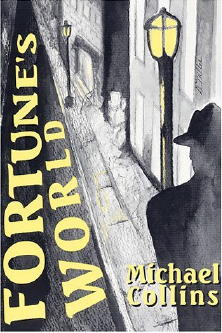 Two short story
collections featuring PI
Dan Fortune, Crime, Punishment,
Resurrection (1992) and Fortune’s
World (2000), have also been published. Sue Grafton wrote
in her insightful introduction to the first collection (eight stories
and a short novel) that “Michael Collins’ touch is deft and his use of
language is economical.” In such stories as “Crime and
Punishment” and “No One Likes to Be Played for a Sucker,” Dan Fortune’s
vision is dark. Solutions involve a “just rewards” heaped on the
bad guy. The fourteen stories in Fortune’s World take place in both
New York City and Santa Barbara, with stops in South American
jungles. Positive reviews for it appeared in EQMM and Los Angeles Book Review. Two short story
collections featuring PI
Dan Fortune, Crime, Punishment,
Resurrection (1992) and Fortune’s
World (2000), have also been published. Sue Grafton wrote
in her insightful introduction to the first collection (eight stories
and a short novel) that “Michael Collins’ touch is deft and his use of
language is economical.” In such stories as “Crime and
Punishment” and “No One Likes to Be Played for a Sucker,” Dan Fortune’s
vision is dark. Solutions involve a “just rewards” heaped on the
bad guy. The fourteen stories in Fortune’s World take place in both
New York City and Santa Barbara, with stops in South American
jungles. Positive reviews for it appeared in EQMM and Los Angeles Book Review.The last Dan Fortune novel (No. 17) to date came as Cassandra in Red in 1992. The one-armed PI is tasked to track down the killer of a homeless lady named Cassandra Reilly, an advocate for those living like herself. Of course, she warms the liberal PI’s heart. Dan Fortune’s resolve to see things out once again takes him down some mean city streets. To sum up, the PI Dan Fortune series has embraced several pioneering risks throughout its durable and brisk run, attempting as it goes to lift the subgenre out of its moribund trenchcoat-and-flask-of-bourbon image. While some have disagreed, I feel that the social and psychological underpinnings of the novels have in no way diluted or distorted the spirit of hardboiled fiction. In contrary fashion, they have only added a deeper and updated human dimension to Dan Fortune as their leading character. In a careful reading of the entire series from start to finish, the voice of Michael Collins stays soulful and crisp, his dialogue pitched as perfectly as possible, and his actions unsparing but compassionate. Dan Fortune is the sort of guy you’d like to strike up a conversation with late at night or in a bus station. He stays a choice friend from book to book. In similar fashion Professor David Geherin has eloquently noted: “In the final analysis, Collins is a writer who uses the private-eye format to fashion mystery novels that are also probing studies of character with a decided philosophical and sociological bent. ... Collins has ... produced a body of work impressive for its consistency and its humanity. By examining the issues of crime and violence from many angles, from the philosophical to the psychological, Collins aims to offer a deeper understanding of what it means to be human, which is, after all, what good literature is really about.” And there is some good news to report. A twentieth PI Dan Fortune novel is in the works. We’ll learn more about that in the interview with Dennis Lynds, a/k/a Michael Collins, that follows. References and Recommended Reading Barzun, Jacques and Wendell Hertiz Taylor, editors. A Catalogue of Crime. New York: Harper & Row, 1989. Book Review Digest. Bronx, NY: H. W. Wilson Company, 1967, 1969 Contemporary Authors. Detroit: Gale Research, 1982. Contemporary Authors New Revision Series. Volume 22. Detroit: Gale Research, 1998. De Andrea, William. Encyclopedia Mysteriosa. New York: Prentice Hall, 1994. Geherin, David. The American Private Eye: The Image in Fiction. New York: Frederick Ungar, 1985. Grafton, Sue. Introduction to Crime, Punishment, Resurrection. New York: Donald I. Fine, 1992. Miller, Ron. “Hard Cases: Disabled Detectives Find New Ways to Solve Crimes.” Mystery! Case Book: Determined Detectives. www.pbs.org/wgbh/mystery/essays/ronmiller.html New York Times Book Review. “Criminals at Large,” Allen J. Hubin. May 19, 1968, p.33. New York Times Book Review. “Crime.” Newgate Callendar. October, 8, 1972, VII, p.33. September 28, 1980, VII, p. 22. Nolan, Tom. Ross Macdonald, A Biography. Scottsdale, AZ: Poisoned Pen Press, 1999. Reilly, John M., editor. Twentieth Century Crime and Mystery Writers. 2nd Edition. New York: St. Martin’s, 1980. “Michael Collins” by Richard C. Carpenter. Michael Seidman, Julian Symons, and Douglas Greene. "Detective Story." Microsoft® Encarta® Online Encyclopedia 2004. http://encarta.msn.com. INTERVIEW WITH
MICHAEL COLLINS (a/k/a DENNIS LYNDS) - Conducted by Ed Lynskey
The following interview was conducted by email in November & December, 2004. Thanks to Steve Lewis and Bill Pronzini for their assistance in formulating several of the questions. 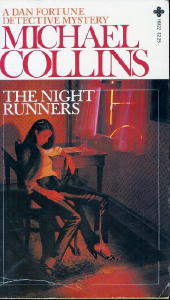 EL: What it is that distinguishes private eye Dan Fortune from all of the other PI’s in the world of detective fiction is, of course, the fact that he has only one arm. What can you tell us about the creative thought processes that went into this idea? Were you thinking ahead and envisioning this handicap as being crucial in the development of Dan Fortune as a protagonist in future stories? If so, how well do you believe you succeeding in doing what you intended to do at the start? Are there any parallels that come to mind with the one-armed man whom David Jansen pursued in the popular TV 1960s series, THE FUGITIVE? Was the real story behind how Fortune lost the arm ever told? DL: The simple answer to this question is, no, I wasn't thinking ahead. But as with most questions about the art of fiction, the reality is far more complex, and usually not completely understood by the author himself. As I’ve said many times, when I was living in New York and writing literary stories and novels one of the people I knew around the bars was a sleazy PI named Harry – last name long forgotten – who made his living by faking “adultery” trysts in divorce cases, catching pilferers and petty-cash thieves for small businesses, and serving summonses. To do much of the dirty work, especially the summonses, he hired “cripples” on the theory people won’t hit cripples. That gave me the idea of creating a kind of “semi-humorous” tongue-in-cheek PI with a flippant manner and very small time cases. But as I wrote the stories, they took on their own life. (See the soon-to-be published collection of all of these early stories, Slot-machine Kelly: The One -Armed Bandit from Crippen & Landru.) First, the pieces became more and more like my literary stories in subject matter, and Slot-Machine became a far more complete, rounded, serious character I renamed Dan Fortune when I wrote my first detective novel, Act of Fear. In the process, the one-arm also took on a life of its own, and became a completely integral part of the character and his psychology and philosophy, and hence a symbolic part of the books themselves. Dan IS a wounded man wounded by the society he lives in. No, the TV series had no connection And, yes, in the first novel, Act of Fear, I give the real story: He lost it when he fell into the hold of a German cargo ship he and his friend Joe Harris were looting. Ending his crime career and shaping his subsequent life. (I used the term “Dutchman” ship because that was what we called Germans in the street argot of pre-World War Two New York, having no experience with the true Hollanders.) EL: Another aspect that makes the series stand out is the narrative focus on liberal socio-economic themes interwoven into the Fortune books. For instance, in Cassandra in Red (1992) the emphasis falls on homeless street people and the excesses of military-minded fanatics. Chasing Eights (1990) looks at the issue of illegal aliens and the single-minded destructive chase of the Almighty Dollar. To me the incorporation of liberal ideas into Dan Fortune’s adventures follow in the tradition of several other crime writers such as Ed Lacy. Might Lacy have had an influence on your writing? DL: The sociological narrative focus follows in the tradition of a great deal of American literature from the Civil War on when Industrialization took over the nation and the world. (Socialism was, after all, born at the same moment as corporate Capitalism.) Dreiser, Norris, Crane, Jack London, Dos Passos, Cain, Goodis, McCoy, Burnett; from the naturalist writers to the proletarian novelists. Hammett was following in that tradition, Chandler and Macdonald to a lesser extent, and me to a greater extent than even Hammett. It is an old tradition in American writing, which hit a peak at the turn of the Nineteenth into the Twentieth century, and again in the Depression years. It is out of favor now, as is anything that doesn’t relate to making a fast buck, beating out your neighbor, or economically raping and conquering the world. I was not influenced by Lacy, since I don’t recall reading him, but I was heavily influenced by all those I’ve mentioned, and especially by Nelson Algren, who remains to me one of the greatest American writers. EL: Your anecdotes and insights about Ken Millar are found in Tom Nolan’s fine biography of Ross Macdonald. How did Mr. Millar influence or help your development as a crime fiction author? DL: Again, I had not read Ken’s work prior to moving to Santa Barbara, so it wasn’t an influence on me at first. Let’s say we were both influenced by the same writers before us, and after I came to read and admire his work I was certainly influenced as, perhaps, he was influenced a bit by me. EL: What other authors had the most effect on you as an author? DL: As I said already, the American naturalists, the muckrakers and proletarians, notably Nelson Algren. Others more for their style would be Conrad, Hemingway, Zola and a lot of European and South American writers. EL: You employ different plot and narrative strategies in the Dan Fortune books such as shifting points of view from first to third person to spin the yarns. Historical elements are inserted such as the Thomas Edison vs. George Westinghouse chapter in Chasing Eights. How far can the envelope be pushed to keep private eye fiction modern, fresh, and vital but also without losing reader credibility and expectations of the genre’s standards? DL: To paraphrase Flannery O’Connor: You can push it as far as you can get away with, and you don’t know how far that is until you try. The only reason you push the envelope is to find new and better ways of telling your story, of making the reader SEE what the story is, what the story is trying to tell us about the human condition. (The narrative alone is not the story. The story is what is behind the narrative, what caused the narrative, what it all adds up to. Not just what happened.) When I take up Dan Fortune again in the next novel, I don’t know what the last ten years are going to make me do. Maybe I’ll pull back, or push in a different direction. Already in the short stories I have been pushing Dan into the past and what events in the lives of his father and grandfather meant to him. 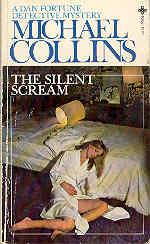 EL: You’ve had a long successful run in the PI Dan Fortune series, books in all. This is similar in number to Bill Pronzini’s “Nameless Detective” series and Robert B. Parker’s Spenser novels. How does an author infuse enough power and interest in a series character to sustain it? DL: I suppose the first answer is that you have to create a character who is in some way interesting enough to bring the reader back again and again. Nowadays most authors try to do that by building an entire life and series of relationships for the detective beyond his or her work on the immediate case or cases and the characters involved with that case or cases. For me that is a tricky business. In my view it is almost impossible to maintain interest in the personal story AND in the immediate story of the book, which is the case and those involved in it. For instance, I don’t care a damn about how Spenser and Susan Silverman are doing from book to book to book. I come from an older school of writing in which the immediate situations and characters of the book, the particular story of the characters involved in the crime, are the main focus, the problem and what it tells us about ourselves and our world. That means it is the different story in each book, and how Dan reacts to it, comments on it, learns from it, that sustains the interest. Dan is a VOICE, a way of looking at the world, and it is that voice that must keep readers coming back. Almost all my best predecessors worked that way. We know nothing about the personal life of the Continental Op, and little about that of Sam Spade except his involvement with Miles’ wife and Brigid O’Shaughnessy. Chandler said about Marlowe’s private life, “I don’t care about his private life.” Macdonald said that if you turned Archer sideways he would disappear. He was a viewpoint, an observer and commentor. What counts is the inherent interest of each individual story in each book. What you get in each of my books, no matter what name they are written under, is a story of a group of human beings caught in a bad situation which Danny tries to understand and show the reader. The sustained interest must come from the voice and actions of my detective making the story of the other characters important and meaningful to each reader personally. If I don’t make you THINK about how the people and events relate to you, then I’ve failed. EL: Should a series protagonist adapt to the times such as Bill Pronzini’s Nameless PI, or remain somewhat static like Sue Grafton’s Kinsey Millhone mysteries? DL: I don’t think it matters, except as it relates to the kind of writer one is. Bill and I tend to write about current situations, therefore our protagonists must age. The only problem with that is, of course, that our detectives will eventually get pretty old if we are fortunate enough to go on as long as we have. Dan is now pretty damned old, and I will have to find a way of dealing with that. Nameless doesn’t have that problem yet, since Bill started writing the series at a much younger age than I did, but if he goes on into the age I have, and I sure hope he does, he’ll have to deal with it too. Sue prefers to keep Kinsey relatively the same age, but that creates a problem too, in that all her books today take place nearly 20 years ago, and she can’t deal with today’s headlines. I guess I never expected to be writing Dan for so long, or living for that matter, but now I have to handle it. Probably by setting the books in the past, and/or “framing them” as I have done with my recent short stories about Dan and his father and grandfather. Those pieces are about father and grandfather but are being told by Dan. 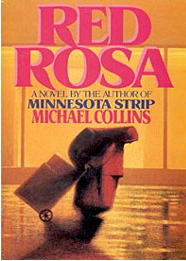 EL: Some of the early Dan Fortune books I’ve read such as The Brass Rainbow (1969) and Shadow of a Tiger (1972) are set in New York City and the later ones which are take place in California. What caused the change in geographical location? DL: I moved from New York. The city was my turf from grade school until I was in my early forties, when I moved with my then wife and two kids to Santa Barbara where I had earlier holed up to write my third mainstream novel. After twelve Fortune books, despite returning to New York regularly, I felt I had lost that edge that comes from living in a place for a long period, and had come to know Santa Barbara and California so well I could move Dan here. It also reflected the true mobility of the U.S. in the late twentieth and early twenty-first centuries, where a crime investigation can and does take you anywhere in the country, and most hard core regionalism has been lost. So in what I considered the true to life situation, I had Dan’s building burn down, and with his girlfriend now on the West Coast, he decided to move west. EL: What differences and similarities do you see between these East Coast and West Coast PI tales? DL: I find no real difference except the landscape and weather, and a certain “frontier” aura and attitude to the back country of California and the mountain states. TV, movies, interstates, air travel, have all joined to make the country far more homogeneous than even fifty years ago. EL: Over the years you must have gotten certain impressions of the publishing industry, both good and bad. On balance, how do you believe you fared in dealings with your publishers? DL: I haven’t had a lot of publishers, but those I’ve had are all about the same. Each had good points and bad points. As long as you remember they are in a business, and that their first loyalty is to that business not to you, you’ll find them mostly consistent. The basic problems have been publicity and promotion, distribution, and money. Publicity, advertising, is generally the worst problem, usually none unless you’re doing so well you really don’t need it. Even fantastic advances don’t guarantee a good PR publicity program. EL: What sort of critical reaction have your books gotten? DL: Generally excellent. Critics and editors love me. It’s publishers who don’t because I’ve never developed a large enough readership for them, especially in paperback. EL: And what kind of response have you gotten directly from the readers of your work? DL: Again, generally good, from those who read me. I have been told that my books make the reader “think, to take some time over.” To me that is the greatest compliment I could get, but I don’t think it was intended totally as a compliment. They meant my books are not a “light” read, not good for lying on the beach, or passing the time while commuting or waiting in a dentist’s office EL: Have any of your Dan Fortune books been adapted as screen plays or television scripts? Which titles do you think might do best as a movie? DL: No, although I had many bites of interest in the early days. I think the problem was threefold: I was not a bestseller; Hollywood people can’t see beyond the immediate surface and the one-arm stopped them (Spencer Tracy aside, most actors don’t want to play a handicapped man); and my novels are very much novelistic in that they rely on the narration and voice of the protagonist and author. How I tell my story is as important to enjoying it as what I tell No idea about which novels would make better movies, except the new thriller I’ve just completed. Being a one-shot thriller, it’s much more cinematic. 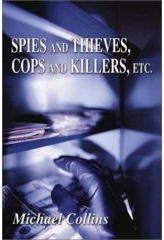 EL: The most recent Dan Fortune novel was Cassandra in Red, which was published in 1992, but a short story collection, Fortune’s World, was published in 2000. You’ve stated in a recent email that you “just sent a new novel to New York – not a Fortune, alas, but that is my next project.” A lot of readers will be pleased to know this. May we make the news official? DL: The thriller, The CEO, is with my agent as we speak, and will be making the submission rounds in January. (New York does nothing in December.) And yes, I do plan to bring back Dan as my next novel. EL: Now that we have the good news that Dan Fortune is returning, can you say something about the new themes and/or causes he will deal with in this beginning of the twenty-first century? Will he get involved somehow, for example, with the problems of post-9/11 and the current war in Iraq and Afghanistan? DL: I can’t imagine him not being involved in what is happening today, especially in what is clearly becoming a critical moment in our history. But, given his age, I’m going to have to find a new way for him to deal with today. I have a few ideas of how to work that, but none that has grabbed me as right yet. EL: On your web site, I noticed you regularly publish short stories in little/literary magazines such as Carolina Quarterly and South Dakota Review. Can you discuss your current and planned literary writing projects (novels and short stories)? How do you balance your literary and crime genre writing? DL: I have always written in both fields, tending to write the literary stories and detective stories in batches, but have also switched from one to the other in short spurts. I always have ideas for both jostling around in my head, but the literary novels come much harder, so I have written few. I write many more literary shorts than novels. Detective novels and literary stories seems to suit me. Over the last ten years I published one short novel, Talking To The World, and have recently finished another, Pictures On A Bedroom Wall, which is now looking for a publisher. I’ve been working on a longer novel titled Gung-Ho, Sam, and Maxine for many, many years, but can’t get it quite right. Of course, what has happened over the years is that the two forms of writing have tended to merge, and I now write my detective novels and stories in a much more mainstream vein, and vice versa. EL: Why did you adopt the pen name of Michael Collins for the Dan Fortune books? Why, in general, has so much of your writing appeared under so many pseudonyms? Was it your choice, in all cases, or was it the idea of the various publishers? DL: You must get tired of asking authors questions because you almost never get simple answers! Okay, at the time – 1967 – I had published two “literary” novels, Combat Soldier, based on my experiences in WW2 that had taken almost ten years to write (I had finished a contemporary novel in the meantime that did not work and had to be scrapped),and Uptown Downtown, a “beat” novel loosely based on my life in New York. Neither title was mine, NAL stuck me with them. I had also published a dozen or so poems – one a 23-page narrative in the manner of Robinson Jeffers in Epoch – and perhaps ten short stories in the literary quarterlies. On the strength of all that I had quit my editorial job and become a full-time writer. I also married again, and soon had two kids. I needed to make money. My fourth literary novel stank. I had started writing crime stories. So I wrote my first Dan Fortune novel, and because I was this “literary” writer, decided to reserve my real name for that. At the same time, Dodd Mead, who bought the book, didn't see Dennis Lynds as a hardboiled name – it was, remember, a different era – so we opted for a pen-name and I picked one of my boyhood heroes, a man my dad had actually met in Dublin, Michael Collins. (It was a bad mistake, it turned out to be a very common Irish name, and has come back to bite me more than once, especially now that there is another Michael Collins just starting out in the crime novel.) 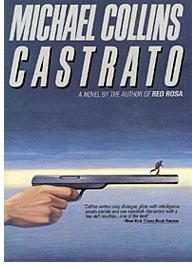 After that, it became a matter of having so many ideas, so much to say, so many stories I wanted to tell, that one publisher couldn't handle all the books, and each publisher wanted another pseudonym for each series! Given that, I picked my own names: William Arden for the Kane Jackson series at Dodd Mead, and for my juvenile novels at Random House; Mark Sadler for my Paul Shaw series at Random House; John Crowe for my Buena Costa County series for Random; and Carl Dekker for my single book at Bobbs-Merrill. On top of that, because I had a family to support, I did a considerable number of works for hire, a lot of them under house names. And once in a while I would have multiple stories in the same issue of a magazine and have to use a pen-name not previously connected to me. As I've said, it was a different era. In those days almost everyone had at least one pseudonym as well as their own name. Many, such as John Creasey, had way more than I ever did. Some writers never did use their real names, e.g. Samuel Clemens. So that was how it happened: A little hubris on my part; a different publishing climate where a name had not yet become a trademark; too much imagination and too many ideas for my own good; and work-for-hire mostly under house names. At the moment, Point Blank Press is planning to correct it all by reissuing almost everything under Dennis Lynds, with the former pen-name duly noted. And, as I said earlier, over the years all my work, literary and detective, has tended to become one and the same. For example, the story for which I had my most recent Edgar nomination (2002) was written as a literary piece but published as a crime story and nominated as such. EL: Have you any last words to leave us with concerning Dan Fortune? DL: I did not set out to write a detective series, but I decided I wanted to write books that probed into the society we live in. We all must relate to others and how we do that determines the kind of society, country, world and universe we will have. As it turned out, I found in the detective story what is perhaps the best form suited to doing just that. A writer is, after all, a kind of detective, and the detective novel is the perfect vehicle for social comment, for socio-drama. EL: Thank you for taking the time to talk to us, especially at this busy time of the year. It was a treat. DL: You're welcome, it was a pleasure doing it. I like to rethink my own thoughts from time to time. It's amazing how much more honest one has to be when putting it in writing, makes you ask yourself : “What DO I think about that?” MICHAEL COLLINS
& DAN FORTUNE: A BIBLIOGRAPHY - by Ed Lynskey & Steve
Lewis
Dan Fortune novels: Act of Fear. Dodd Mead, 1967; Michael Joseph (UK), 1968. Hardcover reprint: Detective Book Club [3-in-1; n.d.]. Paperback reprints: Bantam H4369, 1969; Playboy Press, 1980; No Exit Press (UK), 1989. Note: The Dodd Mead first edition is extremely hard to find. The only copy showing up on ABE is in poor-fair condition. The asking price is $90. The Brass Rainbow. Dodd Mead, 1969; Michael Joseph (UK), 1970. Hardcover reprint: Detective Book Club [3-in-1; n.d.]. Paperback reprints: Bantam H5328, 1970; Playboy Press, 1980. Night Of The Toads. Dodd Mead, 1970; Robert Hale (UK), 1972. Paperback reprints: Bantam S6548, 1971; Playboy Press, 1981. Walk A Black Wind. Dodd Mead, 1971; Robert Hale (UK), 1973. Paperback reprints: Playboy Press, 1978; Carroll & Graf, 1989. Shadow Of A Tiger. Dodd Mead,1972. Paperback reprint: Playboy Press, 1978. The Silent Scream. Dodd Mead, 1973; Robert Hale (UK), 1975. Paperback reprint: Playboy Press, 1979. Blue Death. Dodd Mead, 1975; Robert Hale (UK), 1976. Hardcover reprint: Mystery Guild [book club; n.d.]. Paperback reprint: Playboy Press, 1979. The Blood-Red Dream. Dodd Mead, 1976; Robert Hale (UK), 1977. Paperback reprint: Playboy Press, 1981. The Nightrunners. Dodd Mead, 1978; Robert Hale (UK), 1979. The Slasher. Dodd Mead, 1980; Robert Hale (UK), 1981. Paperback reprint: Playboy Press, 1981. Freak. Dodd Mead, 1983; Robert Hale (UK), 1983. Hardcover reprint: Mystery Guild [book club; n.d.]. Paperback reprint: Worldwide Library, 1990. Minnesota Strip. Donald I. Fine, 1987. Paperback reprints: Worldwide Library, 1988; No Exit Press (1st UK), 1990. Red Rosa. Donald I. Fine, 1988. Paperback reprints: Worldwide Library, 1989; No Exit Press (1st UK), 1992. Castrato. Donald I. Fine, 1989. Paperback reprints: Leisure Books, 1991; No Exit Press (1st UK), 1991. Chasing Eights. Donald I. Fine, 1990. Paperback reprints: Leisure Books, 1992; No Exit Press (1st UK), 1991. The Irishman's Horse. Donald I. Fine, 1991. Cassandra In Red. Donald I. Fine, 1992. Short story collections: Crime, Punishment and Resurrection. Donald I. Fine, 1992. Introduction by Sue Grafton. Crime and Punishment. A Matter of Crime, Volume 3, Matthew J. Bruccoli & Richard Layman, editors, Harcourt Brace Jovanovich [HBJ], 1988. No One Likes to Be Played for a Sucker. EQMM, July 1969. Black in the Snow. An Eye for Justice, Robert J. Randisi, editor, Mysterious Press, 1988. Who? AHMM, August 1972 The Motive. A Matter of Crime, Volume 2, Matthew J. Bruccoli & Richard Layman, editors, HBJ, 1987. The Woman Who Ruined John Ireland. AHMM, November 1983, as “Dan Fortune and the Hollywood Caper.” The Oldest Killer. The Thieftaker Journals, November 1983. The Big Rock Candy Mountains. Resurrection. [Short novel, nearly 40,000 words.] Fortune’s World. Crippen & Landru, 2000. Introduction by Richard Carpenter. Scream All the Way. AHMM, October 1969. Long Shot. AHMM, July 1972. Eighty Million Dead. The Eyes Have It, Robert J. Randisi, Editor, Mysterious Press, 1984. A Reason to Die. The New Black Mask Quarterly No.2, Matthew J. Bruccoli and Richard Layman, editors, HBJ, 1985. Killer’s Mind. The New Black Mask, No.6, Matthew J. Bruccoli and Richard Layman, Editors, HBJ, 1986. The Chair. Justice for Hire, Robert J. Randisi, editor, Mysterious Press, 1990. Murder Is Murder. Constable New Crimes 1, Maxim Jakubowski, editor, Constable (UK), 1992. Role Model. Deadly Allies, Robert J. Randisi and Marilyn Wallace, editors, Doubleday, 1992. Angel Eyes. Deadly Allies II, Robert J. Randisi and Susan Dunlap, editors, Doubleday, 1994. Can Shoot. Private Eyes, Mickey Spillane & Max Allan Collins, editors, Signet, 1998. A Matter of Character. Partners in Crime, Elaine Raco Chase, editor, Signet, 1994. Culture Clash. EQMM, November 1994. A Death in Montecito. EQMM, April 1995. Family Values. Uncollected stories [Dan Fortune] – Disney World. EQMM, May 2002. Twilight's Last Gleaming. Flesh and Blood: Dark Desires, Max Allan Collins and Jeff Gelb, editors, Mysterious Press, 2002. Next-Door Dave. EQMM, July 2004, EQMM. Someone. The Mammoth Book of Roaring Twenties Whodunits, Mike Ashley, editor, Carroll & Graf, 2004. Cross Of Gold. Sherlock Holmes: The Hidden Years, Michael Kurland, editor, St. Martin’s, 2004. The Kidnaping of Xiang Fei. Murder in Vegas, Michael Connelly, editor, Forge, 2005. Slot-Machine Kelly, short stories: “The Dreamer.” Standalone pamphlet published with the limited edition of Fortune's World (Crippen & Landru, 2000). Mike Shayne Mystery Magazine (MSMM) , September 1962, as by Dennis Lynds. Slot-Machine Kelly: The One-Armed Bandit, attributed to “Dennis Lynds writing as Michael Collins.” Crippen & Landru, scheduled for publication, 2005, as part of their “Lost Classics” series. Introduction by Robert J. Randisi. The stories originally appeared as by Dennis Lynds. If the Whiskey Don’t, The Women Will. MSMM, August 1962, as “It’s Whiskey or Dames.” The Bodyguard. MSMM, October 1962. Carrier Pigeon. MSMM, February 1963. The Blue Hand, MSMM, April 1963. The Price of a Dollar. MSMM, June 1963. Even Bartenders Die. MSMM, August 1963. Death for Dinner. MSMM, October 1963. The Heckler. MSMM, November 1963. No Way Out. MSMM, February 1964. Winner Pay All. MSMM, May 1964. The Hero. MSMM, May 1965. Viking Blood. Manhunt, April/May 1966. One non-Dan Fortune crime novel has appeared under the Michael Collins byline: The Cadillac Cowboy. Donald I. Fine, 1995. Description: “Michael Collins turns his sights on Santa Barbara in a novel evocative of CHINATOWN, replete with complex characters, mysterious money, lust and murder.” Leading character: “Langford ‘Ford’ Morgan, ex-soldier, ex-CIA, ex-go-between in the drug wars from Southeast Asia to Colombia,” who comes out of a self-imposed exile. Teaser from Dennis Lynds: “Keep an eye on Ford Morgan, who may or may not be the same man known previously as “The Irisman,” and who may appear in another Dan Fortune novel, and, if I live that long, in more of his own books.” One non-Dan Fortune story collection has appeared under the Michael Collins byline: Spies and Thieves, Cops and Killers, Etc. Five Star, 2002. Occupational Hazard. AHMM, September 1972, as by John Crowe. Death, My Love. MSMM, February, 1963, as by John Douglas. The Bizarre Case Expert. EQMM, June 1970, as by William Arden. Success of a Mission. Argosy, April 1968, as by William Arden. Silent Partner. AHMM, May 1964, as by Dennis Lynds. Man on the Run. MSMM, March 1963, as by Dennis Lynds. Freedom Fighter. The Literary Review, Winter 1962. Harness Bull. MSMM, July 1963, as by Dennis Lynds. Homecoming. MSMM, September 1964, as by Dennis Lynds. Nobody Frames Big Sam. AHMM, October 1963, as by Dennis Lynds. The Sleeper. The Man from U.N.C.L.E., October 1967, as by Sheila Lynds. The Savage. Argosy, January 1970. The Choice. AHMM, February 1973, as by Mark Sadler. Clay Pigeon. Argosy, March 1971 Hard Cop. MSMM, July 1964, as by Dennis Lynds. Hot Night Homicide. MSMM, August 1968. A Part of History. Death by Espionage, Martin Cruz Smith, editor, Cumberland House, 1999. One non-Dan Fortune story has appeared under the Michael Collins byline: “The Horrible, Senseless Murders of Two Elderly Women.” Fedora: Private Eyes and Tough Guys, Michael Bracken, editor, Wildside Press, 2001. Available on-line at http://www.dennislynds.com/horrible.html Two science fiction novels also appeared under the Michael Collins byline: Lukan War. Belmont Books, 1969. The Planets Of Death. Berkley Books, 1970. NOTE: Only books and stories appearing as by Michael Collins are included in this bibliography. For a much more extensive listing of Dennis Lynds’ work, go to Kevin Burton Smith’s “Thrilling Detective” website: http://www.thrillingdetective.com. Other sources used: www.abebooks.com William G. Contento “Mystery Short Fiction.” http://users.ev1.net/~homeville/msf/ Douglas G. Greene of Crippen & Landru, private emails. http://www.crippenlandru.com/ Allen J. Hubin, Crime Fiction IV. Dennis Lynds: www.dennislynds.com/ ________________________ YOUR COMMENTS ARE WELCOME. stevelewis62 (at) cox.net This article, interview and bibliography previously appeared in Mystery*File 47, February 2005. Copyright © 2005 by Steve Lewis. All rights reserved to contributors. |